|
Back to Case Studies
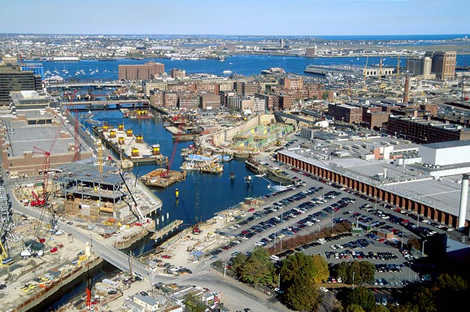
Fort Point Channel Crossing
“The Big Dig”
The Big Dig (officially known as The Central Artery/Tunnel project) is the
largest, most complex, expensive and technologically challenging highway project ever undertaken in the U.S. The city is replacing an outdated highway infrastructure with a
new state-of-the-art highway system, most of which will be underground or underwater. The eighteen-year, eleven-million-dollar project consists of two major components: the
new eight-to-ten-lane underground expressway, and the extension of I-90 (the Massachusetts Turnpike) from its current end-point south of downtown Boston, through
the Ted Williams Tunnel, to Logan Airport. Five major new highway interchanges and a two-bridge crossing of the Charles River are also being built. When it is completed, the
Big Dig will reconnect downtown Boston with its waterfront neighborhoods and the historic North End.
The History
Boston, Massachusetts has a major traffic problem consisting of an outdated
Central Artery made up of six lanes running through the center of downtown. It was originally designed to carry 75,000 vehicles per day and today it carries over 200,000
vehicles per day. The traffic is slow, accident rates are high and the problem is escalating making it one of America’s most congested highways. In addition, this
elevated highway has segregated the historic North End of the city and waterfront area from the rest of the downtown area limiting their ability to participate in the economic life of the rest of the city.
FOAM-TECH’S role at The Big Dig
The tunnel construction method being used consists of ground-freezing
technology. The strength of frozen ground is usually higher than concrete and it is impermeable which makes it highly effective in shoring applications where there is a high
water table with wet, loose soil. Freezing the ground stabilizes the caving soil and prevents groundwater seepage into the excavation sites. It eliminates the need for
dewatering, it is easily installed, and can be completely removed after construction, returning the site to its pre-existing condition. It is cost effective and environmentally safe. The ground freezing projoject by FOAM-TECH was the largest frozen earth retaining project in history.
Once the ground has been frozen and the excavation begins, FOAM-TECH
technicians spray-apply a minimum of 4” of polyurethane foam onto a layer of chicken wire that has been closely installed to the frozen, freshly excavated earth walls. This
layer of insulation keeps the earth frozen at the excavation site. This prevents the soil from thawing and caving into the excavated area. This is especially important to
maintain a firm, usable surface at the rim of the site, preventing cave-ins and groundwater seepage. The FOAM-TECH polyurethane foam assures the effectiveness of the ground-freezing technology.

A road header excavated the soil ahead of the tunnel box. The road
header had a rotating grinder on the end of a moveable arm that chewed out
the frozen soil, which was gathered up and removed from the back of the tunnel
box into a large bucket and carried out by a crane on the surface. The road
header ground away the soil around the freeze pipes, which were cut away.
Click on a photograph for a larger image.
|
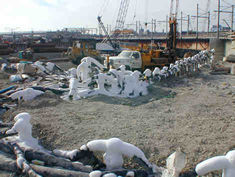 |
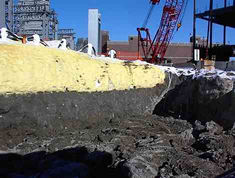 |
|
Hundreds of pipes were driven into the ground between the tracks. Inside the steel pipes were smaller plastic pipes. A freezing plant near the railroad tracks
pumped a brine mixture that remained in liquid form below 32 degrees Fahrenheit into the inner plastic pipes. The brine ran out the bottom of the inner pipe, flowed up to the top inside. |
FOAM-TECH’s role was to insulate the excavated areas to ensure the ground remained frozen. Note the heads of the freeze pipes at the top of the wall. |
|
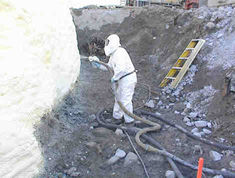 |
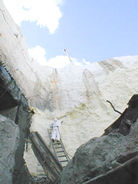 |
| Brian Cote, one of our Lead Technicians, sprays polyurethane foam insulation on a recently excavated area. |
The areas of ground requiring insulation
increase dramatically as the excavation progresses. |
|
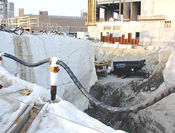 |
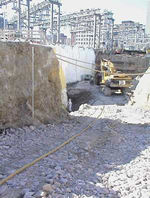 |
|
Because it was critical that the ground remain frozen, FOAM-TECH needed to mobilize within four hours after each excavation. |
Extra long hoses allow FOAM-TECH technicians to spray-apply the polyurethane foam at a significant distance from the truck.
When extra long hoses are not feasible, portable equipment is utilized. |
|
 |
 |
| |
|
|
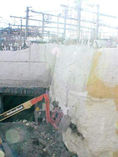 |
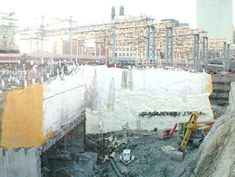 |
| |
|
|
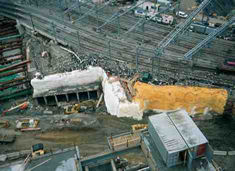 |
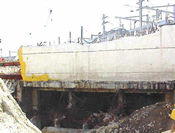 |
| |
|
|
 |
 |
|
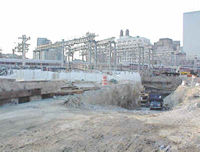 |
Back to Case Studies
| 



















